2018 Honda Goldwing Touring test: more watts, less cotton wool
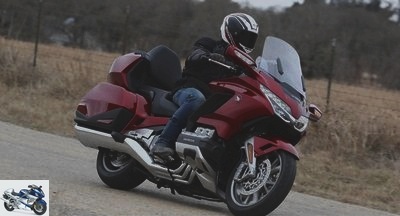
On an exceptional motorcycle, exceptional measures: after 17 years without major evolutions, the Honda Goldwing is reinventing itself with great reinforcements of technology to – finally – offer the sophistication expected of such a limousine on two wheels. A little more powerful and much lighter, the 2018 Gold Wing is above all more dynamic! Test.
2018 Goldwing Touring test – Page 3 – Technical point
Engine
Despite rumors announcing the return to a 4-cylinder to gain in compactness, as on the first Goldwings, Honda has renewed its majestic six-cylinder flat on its "Golden Wing" 2018. This unique engine in motorcycle production – that of the BMW K1600 is in line – however evolves in depth in order to reduce its length (-29 mm) and its weight (-6.2 kg).
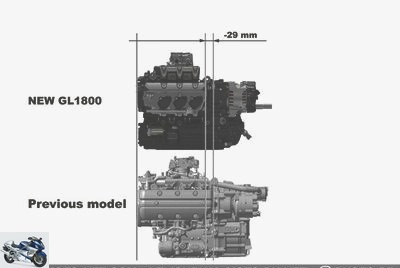
In detail, the Tokyo engine manufacturers have slightly offset the cylinder banks in order to bring the cylinders closer together, while the liners are now made of aluminum. The crankshaft pins are also offset – by 4 mm -, always with a view to saving space.
The exhaust also benefits from this slimming regime: the section of the collectors of the 6-in-2 line has been reduced by "20%" on two cylinders, while the glass wool used on the old Gold is removed to gain weight. Admission now goes through a single body (two in 2017), the volume of which is 10% lower.
The displacement increases by 1 cc (from 1832 to 1833 cc), while the bore and stroke increase from 74×71 mm to 73×73 mm. Objective: gain in punch, as the compression increases from 9.8 to 10.5. Another important change: the number of valves goes from two to four per cylinder, or 24 in all.
A simple camshaft with concentric axes – as on the CRF – operates everything. Thanks to these developments, the power climbs from 118.3 to 126.4 hp (+8.2 hp), at the same speed as in 2017: 5500 rpm, knowing that the rupture occurs at 6500 rpm (as in 2017). We are still a long way from the 160 hp of the BMW K1600, but the increase is no less important for this motorcycle with cardan transmission. !
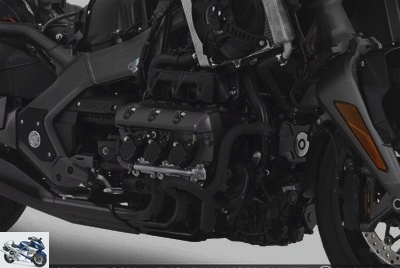
The torque increases from 167 to 170 Nm (close to 175 Nm of the BMW six-cylinder), but its maximum value is obtained 500 revolutions higher: at 4500 rpm instead of 4000 previously. The maximum speed is electronically limited to 180 km / h, while the autonomy is slightly reduced due to the lower capacity of the tank, which goes from 25 to 21.1 liters (-3.9 l).
But thanks to better control of consumption (5.6 l / 100 km theoretical instead of 6.5 l / 100 km), this refining of the can would be almost without consequences: the range of action would still be 377 km, only "8 km less than in 2017", assures Honda. MNC for its part recorded 6.23 l / 100 km at the pump on a straight path of 160 km at a peaceful pace.
Among the tools used to reduce consumption: Idling Stop, an automatic engine cut-off system introduced by Honda on its scooter. This IDS stops the six-cylinder after three seconds of stopping, then restarts it smoothly at the slightest action on the throttle, now electronic type (accelerator without cables called "throttle by wire").
Finally, the new six-speed gearbox (plus the standard reverse gear) receives a limited slip clutch as a replacement for the old hydraulically operated clutch. This device offers both a saving of space and a resistance to the lever reduced "by about 20%", an immediately verifiable observation. Gear changes are smoother and quieter than the old five-speed gearbox, which is much slower and noisier.
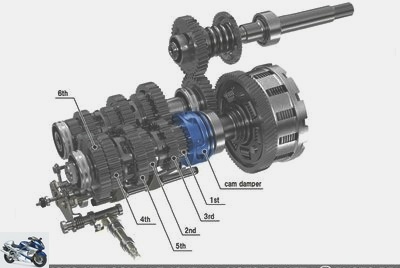
This technological innovation only concerns the manual gearbox version of the 2018 Goldwing, knowing that the Honda flagship incorporates the dual clutch Dual Clutch Transmission. This third generation of DCT – only available in France on the "Tour DCT / Airbag" version – revolves around seven speeds, one more than other Honda motorcycles equipped with this device..
Operation remains the same as that discovered on the in 2009: one clutch takes care of odd gears (1st, 3rd, 5th and 7th now), while the other manages even gears (2nd, 4th and 6th). In this way, the next gear is automatically pre-engaged by the "inactive" clutch, which allows ultra-fast transmission without load cut-off as with a "real" automatic gearbox..
Two gear selection modes are available: manual gear change via "+/-" paddles located on the left hand and an automatic gearshift function (D, like Drive) with which the electronics alone decide when to go up and get off the gears.
Unlike other Honda motorcycles equipped with this device (the series des, la, l ‘or la, there is no second automatic "S" function, more sporty. The reason is that the Gold already offers four driving modes, which act on the responsiveness of the DCT at the same time as the sensitivity of the ABS, traction control and controlled suspensions.
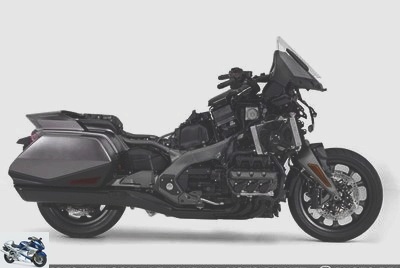
And if the behavior of this "box of tricks" does not suit a given situation, it is also possible to up and down a gear at any time via the paddles on the handlebars. However, the DCT blocks requests deemed inappropriate (excessive sub-regimes or over-revs) and automatically takes over.
Finally, this DCT transmission releases a new feature called "maneuver modes", which allows it to move smoothly at 1.8 km / h and back at 1.2 km / h. When activated, this function uses the + and – paddles on the left to move forward and backward. Convenient for maneuvers and parking !
As for maintenance, the service interval is 12,000 km as on the old model, Honda specifies to MNC. The distribution drive remains entrusted to a chain, a choice adopted by Honda since 2001 and the passage from 1500 to 1800 cc (front belt).
Cycle part
Thanks to the space saving on the engine, Honda was able to redesign the cast aluminum chassis of the 2018 Goldwing. Narrower and lighter by 2 kg, this new frame displays geometric values substantially similar to 2017: the caster angle increases slightly (30.5 ° vs. 29.15), while the wheelbase is 1695 mm (+5 mm).
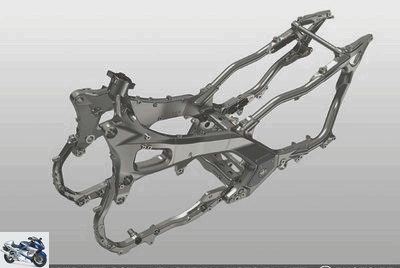
But the main development – the revolution! – touches on the new double wishbone train of this 2018 vintage. Honda adopts for the first time on its Goldwing an unconventional front axle, visually very close to the Duolever used by BMW on some of its motorcycles, of which the rival is front of the Goldwing. Funny coincidence, isn’t it ?!
The winged crest justifies this choice by its desire to improve both the agility and the stability of its bike, while taking advantage of the separation of the steering and damping functions offered by this kinematics. In practice, a front axle of this kind greatly reduces mass transfers, which allows the motorcycle to turn while maintaining significant braking pressure..
The front wheel thus rests between two sturdy triangles which are directed by a transverse steering bar installed between the handlebars and the front axle. This complex assembly works via two links, while a mono-shock absorber in the central position takes care of the damping..
Thanks to this new device, Honda announces an increased operating smoothness of "30%" and a gain in agility of the order of "40%". In addition, this kinematics allows a displacement of the engine of "40 mm" forwards. The riding position changes accordingly: the rider is thus advanced by "36 mm" compared to the old version, but also 5 mm higher since the saddle (not adjustable) now culminates at 745 mm.

It should also be noted that this new vintage is less oriented towards "Pullman" comfort, largely because of its search for compactness and increased performance. Honda has designed a more dynamic motorcycle, therefore less ultra-road, as confirmed in particular by the reduction in the carrying capacity from 150 to 110 liters and the noticeable reduction in the space between the pilot and his passenger..
The chassis also features a redesigned single-link rear suspension and a larger air tire at the rear: 200 / 55-16, against 180 / 60-16 in 2017. The front wheel, shod in Bridgestone, renews its dimensions of 130 / 70/18. The rims are elbow valves from Enken, on which it is recalled that they are made in Japan.
Braking is improved through new 6-piston radial calipers, replacing the axially mounted 3-piston from the previous model. These Brembo clamps bite 320mm discs, which is 24mm longer than before (316mm at the rear, as in 2017). Everything is managed by a new fully combined ABS called "Dual-Combined Braking System", which electronically distributes the braking forces between the front and the rear..
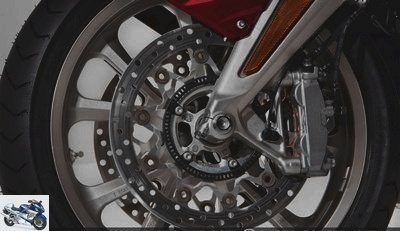
This "D-CBS" – not disconnectable – also participates in the massive weight reduction announced for 2018, with 1.3 kg less on the scale. In its "Bagger" version which now becomes the standard model, the Goldwing 2018 is displayed at 365 kg, or 27 kg less than in 2017. Remember that this version formerly called "F6B" has no top-case and adopts a "chopped" windshield.
The gain rises to 34 kg for the Goldwing Touring with manual gearbox (379 kg) while the new Touring DCT / Airbag would admit only four additional kilos (383 kg). This small difference is however puzzling, insofar as the previous generation of DCT alone weighs 10 kg and the weight of the airbag must also be added, of the order of 5 to 6 kg….
There, MNC raised this issue with Honda without obtaining a satisfactory response. We are continuing to investigate this matter …
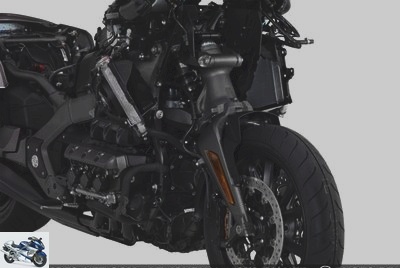
Finally, the 2018 Goldwing adopts an electronically managed damping system, like most modern high-end motorcycles. Depending on the driving mode selected (Tour, Sport, Econ and Rain), stepper motors act on the opening of the suspension valves, which makes it possible to vary in real time the hydraulic adjustment at the front and in back.
The rear spring preload adjustment is separate from the driving modes: the pilot can adjust it as he sees fit by entering the instrumentation submenus. The system offers four types of preload, set at the factory according to the intended use: solo, duo, loaded solo and loaded duo. Note that this setting only acts on the rear shock absorber: the front spring is adjusted once and for all in the factory, like … the BMW Duolever !
Electronic
Practically unchanged technically since 2001 (!), The Goldwing had taken a serious blow of old compared to its competitors, especially from the point of view of equipment and electronic assistance. Honda makes a clean sweep of the past with a motorcycle now at the forefront of sophistication.
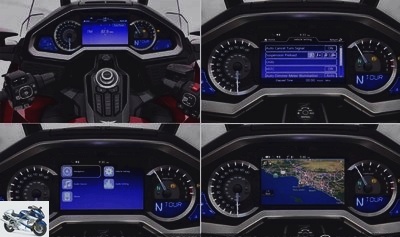
This metamorphosis begins with the appearance of four driving modes (in order: Sport, Tour, Econ and Rain) which influence the response of the accelerator via injection, but also the sensitivity of the traction control ( new in 2018) and ABS, as well as the setting of the suspensions. The "Gold" is thus logically less responsive to the throttle and more flexible damping in "Rain" mode than in "Sport" mode.
- Tower: direct and full power transmission (100%), "standard" front / rear suspensions and brake distribution
- Sport: "throttle grip / throttle opening" ratio of up to 150%, stiffer suspensions, higher pressure at the rear brake
- Econ: 60% ratio, "standard" suspensions and braking
- Rain: ratio between 35 and 50%, flexible suspensions, "standard" braking
On the Tour "DCT / Airbag" version, these modes also affect the responsiveness of the automated gearshift. All this information is clearly presented on the new 7-inch TFT color matrix instrumentation, not far from the format of most touch tablets (between 9 and 11 ”, depending on the brand).
The flagship of the Honda range also releases a new hill start assistant, the Hill Start Assist, which locks the rear brake for a few seconds to facilitate maneuvering. An electric windshield done – finally! – its appearance on the Goldwing: the latter is adjustable in height from an accessible dedicated command on the left stalk. A real revolution !
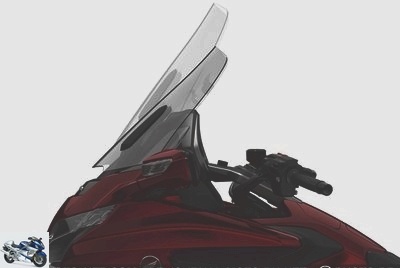
The Golden Wing also receives a Smart Key remote control starting system, which eliminates the need to insert a key in the switch to start the six-cylinder. This remote control-transponder also makes it possible to remotely operate the locking of the suitcases and the top-case (which, remember, is now difficult to close on two full-face helmets).
In addition to cruise control and a new tire pressure indicator, the 2018 Goldwing is also fitted as standard with a GPS guidance system which has its own gyrocompass, which allows it to continue operating in "off-signal" areas. "like in a tunnel, for example.
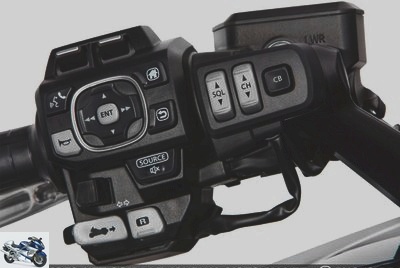
The aging audio system is also undergoing profound changes with new, much more efficient speakers and connectivity in line with the expectations of the rider of the 21st century: Bluetooth or USB pairing are on the program. No more big "80s" typed touches on the fairing references !
The Honda even becomes the first motorcycle to receive the Apple CarPlay system, which allows information and applications from your mobile phone to be transferred to the dashboard. This interesting feature has only one flaw: it only works with iPhones, ie "multifunction mobiles" – the new official name for smartphones in France – from the brand to the apple…
- Honda Goldwing Touring technical sheet in .
Related articles
-
2018 Honda Goldwing Touring test: more watts, less cotton wool On an exceptional motorcycle, exceptional measures: after 17 years without major…
-
2018 Honda Goldwing Touring test: more watts, less cotton wool On an exceptional motorcycle, exceptional measures: after 17 years without major…
-
Africa Twin 2016 test: Honda takes over from the desert Basically, a trail is a motorcycle that is easy to handle and comfortable on all terrains. Honda…
-
Duel BMW K1600GTL Vs Honda GoldWing 2018: Cruising Face Off… Forget Commander Stubing and his Love Boat . Rather, embark with Site for a cruise that is…
-
2017 Kawasaki Z1000SX review: a super bike for the road Kawasaki is taking advantage of the changeover to Euro 4 to refine its Z1000SX on many fronts:…
-
Test Triumph Tiger 1200 XRT and XCA 2018: ready for the road adventure Electric window, keyless start, hill start assistant, directional lights,…
-
KTM 1290 Super Adventure S test : maxi-trail maxi performance ! Only two years after its release, the KTM 1290 Super Adventure is evolving in depth and…
-
2018 Honda Goldwing Touring test: more watts, less cotton wool On an exceptional motorcycle, exceptional measures: after 17 years without major…
-
Road test – F900XR test: the new BMW Sport GT motorcycle – F900XR test page 3: Technical update
F900XR test: the new Sport GT BMW motorcycle In 2020, BMW stops the F800GT but does not abandon the segment of sporty road bikes of medium displacement….
-
Roadster – Test Honda CB1000R 2018: change of universe – Test CB1000R 2018 – Page 3: Technical point
2018 Honda CB1000R Test: Change of Universe Ten after making headlines, the Honda CB 1000 R is looking for a new style. Storing her modern influences in…